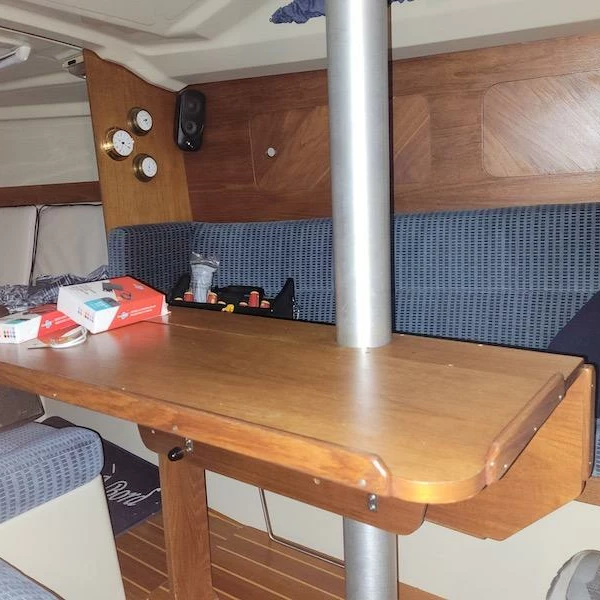Seller's Description
CANADIANTAXES PAID
Well maintained, electricity redone including mast wiring, new GPS/Map plotter/fish finder/radar electronics, sealed porthole, new 135% Genoa (never used), new BBQ and television. Automatic pilot.
Clean and ready to go. Ber fixed on a brand new registered trailer with electric brakes and new lighting system and launching extension;can be moved ANYWHERE.
simon@vsfyacht.com
Equipment: FEATURES
Electrical Equipment
Shore Power Inlet ✓ Electronics
Depthsounder ✓ Radar ✓ Log-Speedometer ✓ TV Set ✓ Plotter ✓ Autopilot ✓ Radio ✓ Compas ✓ GPS ✓ VHF ✓ Inside Equipment
Electric Bilge Pump ✓ Oven ✓ Manual Bilge Pump ✓ Marine Head ✓ Additional Equipment
Road Trailer ✓ Launching Trailer ✓ Rigging
Steering Wheel ✓ Sails
Battened Mainsail ✓ Asymmetric Spinnaker ✓ Furling Genoa ✓ PROPULSION
Engine Make Volvo-Penta Engine Model 2002 867806 Engine Year 1988 Total Power 18hp Engine Type Inboard Drive Type Stern Drive Fuel Type Diesel Propeller Type 2 Blade SPECIFICATIONS
Speed & Distance
Cruising Speed 5.4kn Dimensions
Length Overall 29ft Max Draft 4.67ft Beam 10.5ft Miscellaneous
Electrical Circuit 12V Tanks
Fresh Water Tank 1 X 10 Gal (Plastic) Fuel Tank 1 X 10 Gal (Aluminum) Holding Tank 1 X 15 Gal (Stainless Steel) Accommodations
Double Berths 2 Cabins 2 Heads 1
Specs
- Designers
- ?
- Builder
- Thames Marine
- Association
- Snapdragon & Mirage Association
- # Built
- ?
- Hull
- Monohull
- Keel
- Twin
- Rudder
- ?
- Construction
- FG
Dimensions
- Length Overall
- 29′ 0″ / 8.8 m
- Waterline Length
- 25′ 3″ / 7.7 m
- Beam
- 10′ 5″ / 3.2 m
- Draft
- 4′ 9″ / 1.5 m
- Displacement
- 8,270 lb / 3,750 kg
- Ballast
- 3,550 lb / 1,610 kg
Rig and Sails
- Type
- Sloop
- Reported Sail Area
- 353′² / 32.8 m²
- Total Sail Area
- ?
Mainsail
- Sail Area
- ?
- P
- ?
- E
- ?
- Air Draft
- ?
Foresail
- Sail Area
- ?
- I
- ?
- J
- ?
- Forestay Length
- ?
Auxilary Power
- Make
- Volvo Penta
- Model
- ?
- HP
- 18
- Fuel Type
- ?
- Fuel Capacity
- 25 gal / 95 l
- Engine Hours
- ?
Accomodations
- Water Capacity
- 30 gal / 114 l
- Holding Tank Capacity
- ?
- Headroom
- ?
- Cabins
- 2
Calculations
- Hull Speed
-
7.7 kn
Classic: 6.74 kn
Hull Speed
The theoretical maximum speed that a displacement hull can move efficiently through the water is determined by it's waterline length and displacement. It may be unable to reach this speed if the boat is underpowered or heavily loaded, though it may exceed this speed given enough power. Read more.
Formula
Classic hull speed formula:
Hull Speed = 1.34 x √LWL
A more accurate formula devised by Dave Gerr in The Propeller Handbook replaces the Speed/Length ratio constant of 1.34 with a calculation based on the Displacement/Length ratio.
Max Speed/Length ratio = 8.26 ÷ Displacement/Length ratio.311
Hull Speed = Max Speed/Length ratio x √LWL
- Sail Area/Displacement
-
13.8
<16: under powered
Sail Area / Displacement Ratio
A measure of the power of the sails relative to the weight of the boat. The higher the number, the higher the performance, but the harder the boat will be to handle. This ratio is a "non-dimensional" value that facilitates comparisons between boats of different types and sizes. Read more.
Formula
SA/D = SA ÷ (D ÷ 64)2/3
- SA: Sail area in square feet, derived by adding the mainsail area to 100% of the foretriangle area (the lateral area above the deck between the mast and the forestay).
- D: Displacement in pounds.
- Ballast/Displacement
-
42.9
>40: stiffer, more powerful
Ballast / Displacement Ratio
A measure of the stability of a boat's hull that suggests how well a monohull will stand up to its sails. The ballast displacement ratio indicates how much of the weight of a boat is placed for maximum stability against capsizing and is an indicator of stiffness and resistance to capsize.
Formula
Ballast / Displacement * 100
- Displacement/Length
-
228.9
200-300: moderate
Displacement / Length Ratio
A measure of the weight of the boat relative to it's length at the waterline. The higher a boat’s D/L ratio, the more easily it will carry a load and the more comfortable its motion will be. The lower a boat's ratio is, the less power it takes to drive the boat to its nominal hull speed or beyond. Read more.
Formula
D/L = (D ÷ 2240) ÷ (0.01 x LWL)³
- D: Displacement of the boat in pounds.
- LWL: Waterline length in feet
- Comfort Ratio
-
21.0
20-30: coastal cruiser
Comfort Ratio
This ratio assess how quickly and abruptly a boat’s hull reacts to waves in a significant seaway, these being the elements of a boat’s motion most likely to cause seasickness. Read more.
Formula
Comfort ratio = D ÷ (.65 x (.7 LWL + .3 LOA) x Beam1.33)
- D: Displacement of the boat in pounds
- LWL: Waterline length in feet
- LOA: Length overall in feet
- Beam: Width of boat at the widest point in feet
- Capsize Screening
-
2.1
>2.0: better suited for coastal cruising
Capsize Screening Formula
This formula attempts to indicate whether a given boat might be too wide and light to readily right itself after being overturned in extreme conditions. Read more.
Formula
CSV = Beam ÷ ³√(D / 64)
- Beam: Width of boat at the widest point in feet
- D: Displacement of the boat in pounds
Notes
Available with fin keel, draft 5ft / 1.52m
This listing is presented by SailboatListings.com. Visit their website for more information or to contact the seller.

















